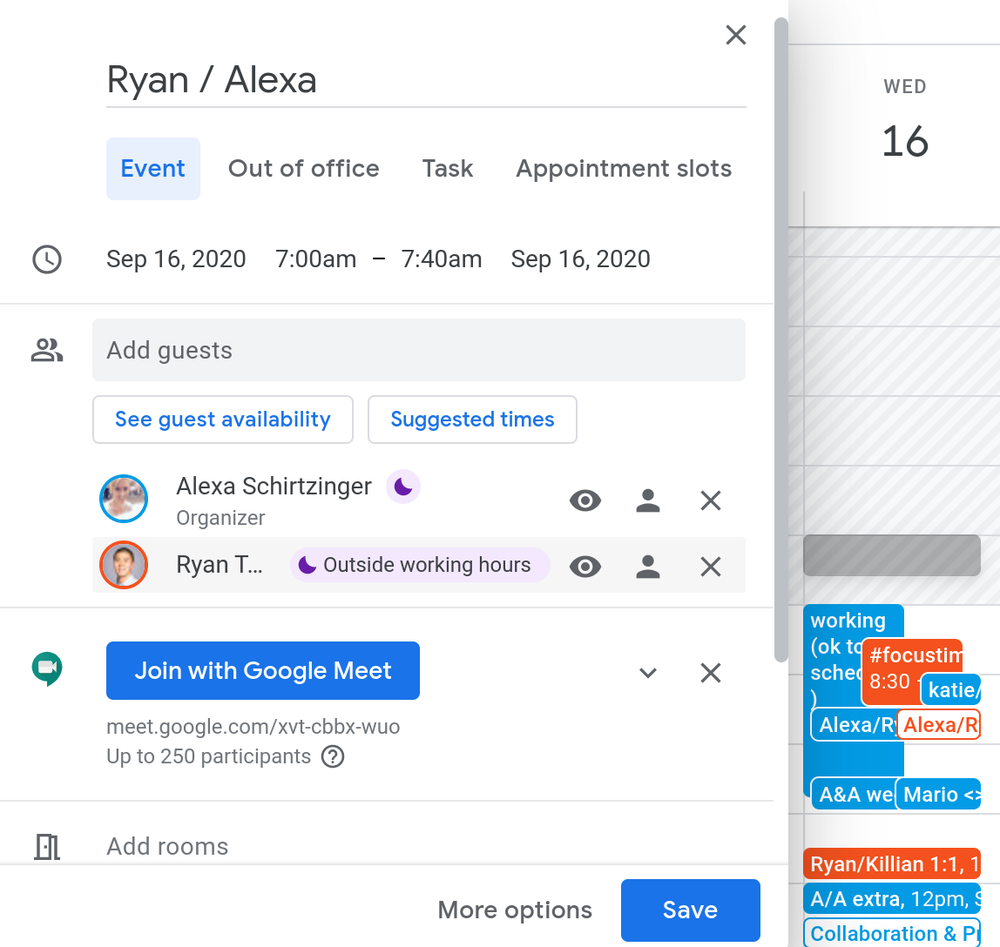G Suite Appointment Slots
- Each appointment booked as an online meeting creates a unique meeting link that is sent to attendees so they can join via a web browser, phone dial-in, or the Skype or Teams app. Bookings is also available as an app within Teams, which allows you to create Bookings calendars, assign staff, and both schedule new and manage existing appointments.
- Calendar is Google's enterprise calendar and scheduling application. Configuring detailed events and open appointment slots is as easy as clicking on a day or time. You can also use Calendar's Find a Time feature to view the free/busy availability of any other AppState Calendar users, making it easy to select a time to hold meetings with your colleagues.
- Guests and non guests may schedule an appointment with the Spa up to 3 months in advance of the day requested by contacting the Spa at 702.693.7472 between the hours of 6:00 AM and 8:00 PM daily. Salon appointments may be scheduled up to 3 months in advance of the day requested by contacting the Salone at 702.693.8080 between the hours of 9:00.

You can label how you see your meetings in your calendar, instead of a default meeting block labelled 'Meeting'. The person who is booking an appointment with you doesn't need to enter in his/her name or email because we already know who it is based on their email address. Log into my.ryerson (your Ryerson Portal) and go to the Apps tab. Note: Appointment slots do not work on your private Google Calendar, they only work on the Ryerson G Suite version. Click on Calendar from the G Suite menu.

1. Log into my.ryerson (your Ryerson Portal) and go to the Apps tab.
Note: Appointment slots do not work on your private Google Calendar, they only work on the Ryerson G Suite version.
2. Click on Calendar from the G Suite menu.
3. Navigate to the week when you want to start your office hour.
4. Click and drag to create a regular appointment spanning the total length of that particular office hour session. An input box appears as shown in the Figure 1. Note that in this example we’re setting up a block of office hours lasting three hours.
5. Click on “Appointment slots” in the input box and you will see a screen shown in Figure 3.
Note: If this is your first time accessing the appointment slots, you will first get a screen explaining what are appointment slots.
6. Click on 'Get started with appointment slots' to go to 'Appointment slots'.
7. Add a title, e.g. “Office Hours” as shown in Figure 3.
8. Click on “More Options”. You will get an edit page for the appointment slots.

9. Click 'Does not repeat' to reveal a drop down menu with options to set the recurrence of the block. Click 'Custom' to set up a custom recurrence of the appointment block. In this case we have set it to repeat every Tuesday and Thursday until August 1st.
10. Clicking Done will take you to the 'Edit details' screen.
11. Add your office room number in the “Location” field.
Note: Please take a note of the 'This calendar's appointment page' text on the screen. You will need this later. Click on the link to open the “Calendar’s appointment page”.
12. Save your changes. You will then be returned to your calendar. You will see block appointments set up over the range you specified, repeated as you specified.
13. Use the “Calendar’s appointment page” link, mentioned in Step 11 above, to embed into your web page or an email so your students can see and visit your calendar.
14. When a student accesses the shared link, they will see something. Twelve different slots are represented here.
15. A student would select one and fill in their personal details. They will see 'Book an appointment' screen.
16. After saving the appointment details, the student will see a confirmation screen.
G Suite Appointment Slots Online
17. When a student books an appointment slot, you will receive an email message showing you the request and giving you the choice to accept or decline the appointment. If you accept it, the appointment will show up in both your google calendar and that of the student.
G Suite Appointment Slots Sign Up
(This page is based on Prof. Fil Salustri's own document on the same topic.)